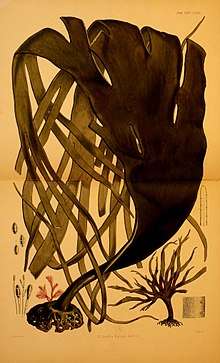Durvillaea
| Durvillaea | |
|---|---|
| Durvillaea antarctica in Otago, New Zealand | |
| Scientific classification | |
| Kingdom: | Chromista |
| Phylum: | Ochrophyta |
| Class: | Phaeophyceae |
| Order: | Fucales |
| Family: | Durvillaeaceae |
| Genus: | Durvillaea |
| Type species | |
| D. antarctica | |
| Species | |
| |
Durvillaea is a genus of brown algae in the monotypic family Durvillaeaceae. It is named after French explorer Jules Dumont d'Urville (1790-1842).[7] There are currently six recognised species within the genus, with the type species D. antarctica.[1] All members of the genus are found in the southern hemisphere, particularly New Zealand, South America, Australia and various subantarctic islands. Many Durvillaea species are referred to as bull kelp, which is a common name for a large kelp.[5][8]
Species
- Durvillaea amatheiae[3]
- Durvillaea antarctica,[2] found in New Zealand, Chile and various subantarctic islands[8] including Macquarie Island[9]
- Durvillaea poha[4]
- Durvillaea chathamensis, unique to the Chatham Islands
- Durvillaea potatorum, endemic to south-east Australia [5][10]
- Durvillaea willana[6]
- Unnamed species found on the Antipodes Islands[8]
Morphology & Ecology
Durvillaea spp. are characterised by their prolific growth, plastic morphology and ability to withstand high levels of disturbance at rocky, wave-exposed coastal sites.[9]
Use of Durvillaea spp.
D. antarctica has been used in Chile as a food item, predominately by the Mapuche indigenous people who refer to it as collofe.[11] In Australia, D. potatorum is collected as beach wrack from King Island, where it is then dried as chips and sent to Scotland for phycocolloid extraction.[12]

References
- 1 2 3 Bory de Saint-Vincent, J.B.G.M. (1826). Laminaire, Laminaria. In: Dictionnaire Classique d'Histoire Naturelle. (Audouin, I. et al. Eds) Vol. 9, pp. 187-194.
- 1 2 3 Dufour, C; Probert, PK; Savage, C (2012). "Macrofaunal colonisation of stranded Durvillaea antarctica on a southern New Zealand exposed sandy beach". New Zealand Journal of Marine and Freshwater Research. 46 (3): 369–383. doi:10.1080/00288330.2012.676557.
- 1 2 Weber, X.A., Edgar, G.J., Banks, S.C., Waters, J.M., and Fraser, C.I. "A morphological and phylogenetic investigation into divergence among sympatric Australian southern bull kelps (Durvillaea potatorum and D. amatheiae sp. nov.)." Mol. Phylogenet. Evol. (2017) 107:630-643.
- 1 2 Fraser, C.I.; Spencer, H.G.; Waters, J.M. (2012). "Durvillaea poha sp. nov. (Fucales, Phaeophyceae): a buoyant southern bull-kelp species endemic to New Zealand". Phycologia. 51 (2): 151–156. doi:10.2216/11-47.1.
- 1 2 3 Cheshire, A.; Hallam, N. (2009). "Morphological Differences in the Southern Bull-Kelp (Durvillaea potatorum) throughout South-Eastern Australia". Botanica Marina. 32 (3): 191–198. doi:10.1515/botm.1989.32.3.191.
- 1 2 Lindauer, V.W. (1949). "Notes on marine algae of New Zealand. I". Pacific Science. 3: 340–352.
- ↑ M. Huisman, John (2000). Marine Plants of Australia. University of Western Australia Press. p. 212. ISBN 978-1-876268-33-6.
- 1 2 3 Fraser, C.I.; Winter, D.J.; Spencer, H.G.; Waters, J.M. (2010). "Multigene phylogeny of the southern bull-kelp genus Durvillaea (Phaeophyceae: Fucales)". Molecular Phylogenetics and Evolution. 57 (3): 1301–11. doi:10.1016/j.ympev.2010.10.011. PMID 20971197.
- 1 2 "Kelp". Australian Antarctic Division: Leading Australia’s Antarctic Program. Department of the Environment and Energy. Retrieved 7 December 2016.
- ↑ Cheshire, Anthony C.; Hallam, Neil D. (1985). "The environmental role of alginates in Durvillaea potatorum (Fucales, Phaeophyta)". Phycologia. 24 (2): 147–153. doi:10.2216/i0031-8884-24-2-147.1.
- ↑ Stuart, Jim (15 April 2010). "Seaweed: Cochayuyo and Luche". Eating Chilean.
- ↑ Kelp Industries (August 2004). "Proposal for the harvest and export of native flora under the Environment Protection and Biodiversity Conservation Act 1999" (PDF).
Further reading
- Adams, N.M. (1994). Seaweeds of New Zealand. Canterbury University Press. ISBN 978-0908812219.
- Morton, J.W.; Miller, M.C. (1973). The New Zealand Seashore. Collins.